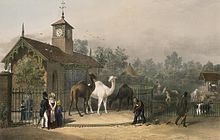London Zoo
| London Zoo | |
|---|---|
| place | Outer Circle, Regent's Park London NW1 4RY |
| surface | 15 hectares |
| opening | April 27, 1828 |
| Animal species | 752 animal species |
| Individuals | 18,499 animals + an ant colony (2011) |
| organization | |
| Sponsorship | Zoological Society of London |
|
View from Primrose Hill |
|
| https://www.zsl.org/zsl-london-zoo | |
The London Zoo ( London Zoo ) is the first zoo to use the name zoological garden , thus referring to the scientific orientation of this institution. In 2011 it housed 18,499 animals from 752 species as well as an ant colony with around 10,000 ants.
It is located at the northern end of Regent's Park in London , the Regent's Canal divides the facility as well as the Outer Circle . The operating company Zoological Society of London also has the Whipsnade Zoo in Bedfordshire , where the larger animals such as elephants and rhinos are housed.
history
The zoo was opened in 1828 as a collection of animals for scientific studies and was initially only accessible to members of the Zoological Society; Outsiders had a written statement of a member ( fellow ) to provide the Company and a shilling to pay. It was opened to the public in 1847.
London Zoo featured the first reptile house in 1849, the first aquarium in 1853, the first insect house in 1881 and the first children's zoo in 1938.
architecture
From the beginning, leading architects were involved in the architecture of his buildings :
- the clock tower (built in 1828 for lamas ) and the giraffe house (1836–1837) were designed by Decimus Burton,
- the Mappin Terraces (1913-1914) were designed by Sir Peter Chalmers Mitchell and John James Joass,
- the reptile house (1927) was designed by Joan Beauchamp Procter and Guy Dawber .
- the penguin pool (1934), a listed building since 1970, the Round House (1932–1933) for the gorillas and the North Gate Kiosk (1936) were designed by Berthold Lubetkin ,
- the aviary Snowdon aviary (1962-1964) was designed by Lord Snowdon, Cedric Price and Frank Newby and
- the former elephant and rhinoceros house (1962–1965) designed by Sir Hugh Casson and Neville Conder
Famous animals
The Egyptian hippopotamus Obaysch was an attraction from his arrival in 1850 until his death in 1878, which at times drew up to 10,000 visitors a day to the zoo. The elephant Jumbo had also been an attraction at the zoo since 1865; The sale of the animal to the American showman PT Barnum turned into a national scandal, in particular because of the extraordinary attention that both the audience and the press paid to the elephant .
In 1870 a quagga lived in London Zoo. The quagga is a now extinct subspecies of the plains zebra .
The black bear Winni came to the zoo in 1914 as a gift from a Canadian officer. The author Alan Alexander Milne animated a visit to the zoo to his stories about Winnie the Pooh .
Plants and buildings
There is a tropical free flight hall in the Blackburn Pavilion . The Butterfly Paradise shows butterflies in all stages of development from many regions of the world including Africa, Southeast Asia and Central and South America. In the complex Asian big cats are Asiatic lions and Sumatran tiger to be seen. The Giants of the Galapagos exhibition features three Galápagos giant tortoises . In the Gorilla Kingdom four western lowland gorillas as well as monitor lizards and mangaben can be observed.
The aquarium is divided into three halls: the first hall contains fish from nature conservation projects, the second focuses on the subject of coral reefs and the third shows the Amazon habitat .
Actions
From August 26th to 29th, 2005, the zoo housed eight people in the bear enclosure as a special species. The action was intended to prove that humans belong to the animal world and show that their distribution is a special scourge for other species.
Web links
- London Zoo website (English)
- London Zoo in the 19th century. (English)
Individual evidence
- ↑ a b as of 2011. Spiegel: Inventory in the London Zoo. Retrieved January 5, 2012.
- ↑ Landmarks in ZSL History. Website of the London Zoological Society. Retrieved May 4, 2020.
- ↑ Beatrice Härig: Stalking a rare genus . Zoo buildings as monuments. In: German Foundation for Monument Protection (Hrsg.): Monuments . Magazine for monument culture in Germany. No. 3 . Monuments publications, 2019, ISSN 0941-7125 , p. 13 .
- ↑ Butterfly Paradise. London Zoo website. Accessed January 16, 2011.
- ↑ Asian big cats. London Zoo website. Accessed January 16, 2011.
- ↑ Gorilla Kingdom. London Zoo website. Accessed January 16, 2011.
- ↑ Half-naked people in the bear enclosure. Focus online. Accessed January 15, 2011.
Coordinates: 51 ° 32 ′ 5 ″ N , 0 ° 9 ′ 15 ″ W.






